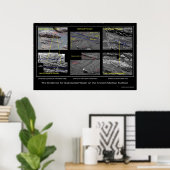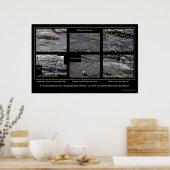
58,30 €
par poster
Poster Evidence of Substantial Water on Martian Surface
Voir les détails du produitA propos de Posters
Vendu (e) par
À propos de ce design
Poster Evidence of Substantial Water on Martian Surface
Cross-bedding Evidence for Underwater Origin Interpretations of cross-lamination patterns presented as clues to the origin under flowing water of the martian rock called “Last Chance†are marked on these images taken by the panoramic camera and microscopic imager (MI Mosaic) on NASA Mars Exploration Rover Opportunity. The red arrows point to features suggesting cross-lamination within the rock in a panoramic camera image taken at a distance of 4.5 meters (15 feet) during Opportunity's 17th sol (February 10, 2004). The inferred sets of fine layers at angles to each other (cross-laminae) are up to 1.4 centimeters (half an inch) thick. For scale, the distance between two vertical cracks in the rock is about 7 centimeters (2.8 inches) as can be seen in the panoramic camera image. The feature indicated by the middle red arrow suggests a pattern called trough cross-lamination, likely produced when flowing water shaped sinuous ripples in underwater sediment and pushed the ripples to migrate in one direction. The direction of the ancient flow would have been either toward or away from the line of sight from this perspective. The lower and upper red arrows point to cross-lamina sets that are consistent with underwater ripples in the sediment having moved in water that was flowing left to right from this perspective. The yellow arrows indicate places in the panoramic camera view that correlate with places in the microscope's view of the same rock. The microscopic view is a mosaic of some of the 152 microscopic imager frames of Last Chance that Opportunity took on sols 39 and 40 (March 3 and 4, 2004). This view shows cross-lamination expressed by lines that trend downward from left to right, traced with black lines in the interpretive overlay. These cross-lamination lines are consistent with dipping planes that would have formed surfaces on the down-current side of migrating ripples. Interpretive blue lines indicate boundaries between possible sets of cross-laminae. Evidence of Soft-Sediment Deformation Geological examination of bedding textures indicates three stratigraphic units in an area called "Slickrock" located in the martian rock outcrop that NASA's Opportunity examined for several weeks. Interpretive blue lines in the upper image (Slickrock Pancam) indicate boundaries between the units. The upper blue line may coincide with a scour surface. The lower and upper units have features suggestive of ripples or early soft-sediment deformation. The central unit is dominated by fine, parallel stratification, which could have been produced by wind-blown ripples. Opportunity took the underlying image from a distance of 2.1 meters (6.9 feet) during the rover's 45th sol on Mars (March 10, 2004). Features labeled with red letters in the top panoramic camera view are also depicted in an enlargement of portions of the image – (Slickrock Zoom-in). "A" is a scour surface characterized by truncation of the underlying fine layers, or laminae. "B" is a possible soft-sediment buckling characterized by a "teepee" shaped structure. "C" shows a possible ripple beneath the arrow and a possible ripple cross-lamination to the left of the arrow, along the surface the arrow tip touches. "D" is a scour surface or ripple trough lamination. These features are consistent with sedimentation on a moist surface where wind-driven processes may also have occurred. Evidence of Ancient Water Flow The Last Chance Pancam view of the lower portion of the martian rock called "Last Chance" shows a close-up of texture interpreted as cross-lamination evidence that sediments forming the rock were laid down in flowing water. NASA's Opportunity took the original image during the rover's 38th sol in Mars' Meridiani Planum region (March 2, 2004). In the central part of the image, the dip of fine layers at angles to each other (cross laminae) suggests that the water that created the cross-lamination was flowing from left to right. Interpretive black lines trace these cross-laminae. Interpretive blue lines indicate boundaries of possible sets of cross-laminae. The lower view (Last Chance Visualization) is a three-dimensional visualization of this portion of the rock and it offers additional details of the cross-lamination. The visualization and the image from the panoramic camera are compared to show a point of correlation (yellow arrow).
Avis des clients
4.7 sur 5 étoiles7 Nombres de Commentaires
7 Commentaires
Avis sur des produits similaires
5 sur 5 étoiles
Par B.7 juin 2021 • Achat sécurisé
impression, Taille: 38,06cm x 31,16cm, Matériel: Aucun, Cadre: Aucun, Format: Papier pour affiche économique (semi-brillant), Mat: Standard,
Programme d'évaluation de Zazzle
Produit de très bonne qualité, belle finition semi-brillante. L'impression est impeccable
5 sur 5 étoiles
Par F.22 juillet 2016 • Achat sécurisé
impression, Taille: 44,13cm x 65,79cm, Matériel: Aucun, Cadre: Aucun, Format: Papier pour affiche économique (semi-brillant), Mat: Standard,
Programme d'évaluation de Zazzle
Finalement! Ma commande est arrivée intacte! Yuppiii!
Et oui celle-ci était la deuxième envoyée par Zazzle...
Ma première commande étant arrivée abîmée (photos incluses), je me suis mis en contact avec le Support de Zazzle qui m'ont proposé un deuxième envoi, à leurs frais.
Merci Zazzle!!
(le transporteur UPS m'a présenté ses excuses). Les couleurs sont parfaites. Imprimées en mat, le support papier est assez solide et consistant, mieux que d'autres posters achetés dans des magasins.
5 sur 5 étoiles
Par Ness L.14 janvier 2021 • Achat sécurisé
impression, Taille: 40,64cm x 50,80cm, Matériel: Aucun, Cadre: Aucun, Format: Papier pour affiche économique (semi-brillant), Mat: Standard,
Programme d'évaluation de Zazzle
satisfait - ce papier d'archive permet un collage facile sur panneau de bois. représente bien les details de l'original
Tags
Autres infos
Identifiant du produit : 228689818070911303
Fabriqué le 08/04/2004 11:11
Évalué G
Articles vus récemment


